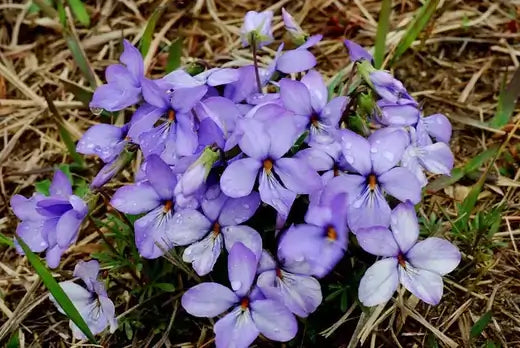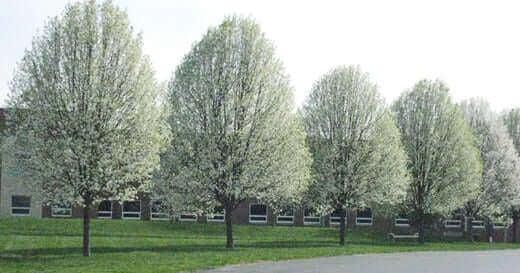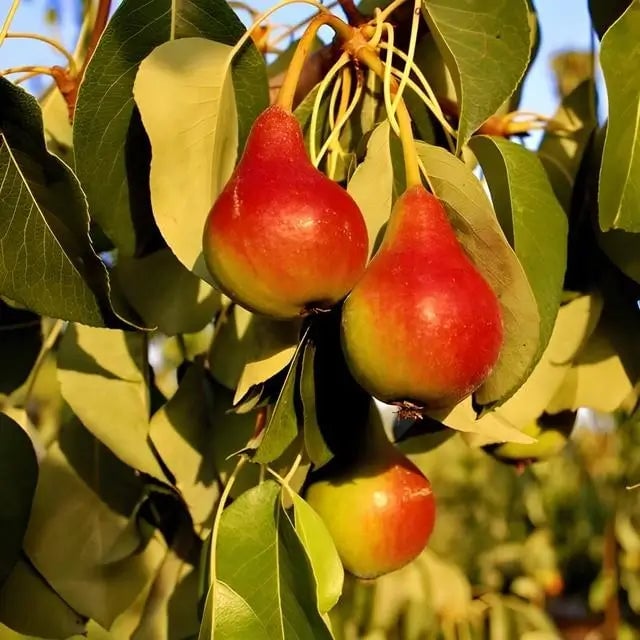Beautiful white-colored beautiful flowers in spring
The flowers bloom and show their excellent effect during the months of late March and early April. The scientific name of Cleveland Pear is Pyrus calleryana.
This tree is from the Bradford Pear Tree family, and it is much sturdier than the other species when it comes to storms. During storms and strong winds, the branches of a Bradford Pear Tree can split and create a mess in your garden.
The Cleveland Pear Tree is sturdier than the Bradford Pear Tree
It has skinny branches so, which makes it a better option for areas that are prone to storms. Unlike the Bradford Pear Tree, which scatters seeds across your garden and new trees emerge, the Cleveland Pear Tree does not do the same because they do not have seeds. Growing your Cleveland Pair This tree is a mid-sized tree and can hold snow and ice due to its stable branches.
They grow 20 – 30 feet in height and around 15 feet in spread. This tree can grow in clay soil. However, moist and fertile soil is preferred. During summers, the tree wears dark green color, and as autumn approaches, they show beautiful purple, red and yellow hues.
This tree is mostly disease and pest resistant and requires less attention. You can find rows of these trees in urban areas along the driveway or pathways. Cleveland Pear is considered a perfect tree for shade, and because of this reason, people love to grow them in their backyard.
Some people grow them for ornamental reasons as they look distinct and appealing during spring. They can occasionally be pruned to maintain the desired shape. Cleveland Pear Tree is ideal for home gardens because of its durability, size, and less maintenance.
The Benefits of the Cleveland Pear
The Cleveland pear, which many call 'Cleveland Select', stands out as an ornamental tree choice due to its visual beauty and ability to thrive in various conditions while being easy to maintain. The Cleveland pear tree from the Callery pear family (Pyrus calleryana) has become popular among homeowners and landscape professionals because of its strong structure and colorful seasonal transformations. These points illustrate why the Cleveland pear tree should be considered for your garden space.
The Cleveland pear stands out due to its attractive upright growth habit. The Cleveland pear stands apart from other ornamental pear species because it develops into a compact and balanced shape. The tree's columnar form fits perfectly into limited spaces and compact landscapes. From an eye-catching garden centerpiece to lining streets and flanking driveways, the Cleveland Pear maintains its polished appearance throughout all seasons.
Pure white flower blooms decorate Cleveland pears during early spring when they burst into full bloom. The blooms establish a remarkable visual display that signals the end of winter as one of the first indications of approaching spring warmth. The flowers remain visible for multiple weeks while pollinators are drawn in. The tree develops glossy green leaves after flowering, creating a neat shape while providing an attractive fullness during summer. During autumn, the Cleveland pear tree displays vibrant red, orange, and occasional purple leaves, adding striking color contrasts to the surrounding landscape. The Cleveland pear maintains its decorative attractiveness every season, which is its primary benefit.
In addition to its visual appeal, the Cleveland pear earns praise for its ability to withstand various conditions. The Cleveland pear thrives across diverse soil types, including sand and clay, while adapting to slightly acidic and alkaline soils. Sufficient watering remains important during its initial growth stage, but the Cleveland pear demonstrates excellent drought resistance once it reaches maturity. The robust nature of this tree allows it to thrive in urban settings where other ornamental trees fail due to compacted soils and space constraints. The Cleveland pear outperforms other ornamental pear varieties in branch strength and wind resistance, resulting in reduced breakage during storm events.
The Cleveland pear requires minimal upkeep, which is an additional advantage. Regular pruning activities usually focus on eliminating dead or damaged branches while helping keep the tree in its best shape. Most owners experience their trees naturally maintaining their tidy columnar shape with minimal maintenance. The Cleveland pear tree demonstrates excellent resistance to pests and diseases, lowering the need for extensive maintenance. Gardeners who want to create an environmentally friendly landscape will find this a helpful strategy.
The Cleveland pear offers practical advantages, including its function as a privacy screen. A grouping of Cleveland pear trees planted near each other forms an aesthetic living shield that also serves to protect against noise and wind and block unwanted sightlines. Compared to many deciduous trees, the Cleveland pear keeps its leaves longer into the fall, thus extending the area of privacy throughout autumn.
The Cleveland pear provides homeowners and landscape enthusiasts with a valuable option thanks to its unique shape, beautiful seasonal displays, high resilience, and low maintenance needs. The combination of thriving in different environments and displaying remarkable beauty makes this option adaptable and gratifying.
Read more

The Viola Pedata, or as it is also called Birds foot violet, is a perennial mountain plant that grows in northeastern American areas.The Appalachian mountain range is the leading home for these wil...

Tuesday, July 26Vegetable Gardening in ContainersContainer gardening is one of the best methods of gardening for most individuals. If you don t possess a suitable plot of land where you can do gard...



